
Stock car racing is a form of automobile racing run on oval tracks and road courses measuring approximately 0.25 to 2.66 miles. It originally used production-model cars, hence the name "stock car", but is now run using cars specifically built for racing. It originates from the United States and Canada; the world's largest governing body is the American NASCAR. Its NASCAR Cup Series is the premier top-level series of professional stock car racing. Australia, New Zealand, Mexico, Brazil and the United Kingdom also have forms of stock car racing. Top-level races typically range between 200 and 600 miles in length.

Motorsport, motorsports or motor sport is a global term used to encompass the group of competitive sporting events which primarily involve the use of motorised vehicles. The terminology can also be used to describe forms of competition of two-wheeled motorised vehicles under the banner of motorcycle racing, and includes off-road racing such as motocross.

A race track is a facility built for racing of vehicles, athletes, or animals. A race track also may feature grandstands or concourses. Race tracks are also used in the study of animal locomotion.
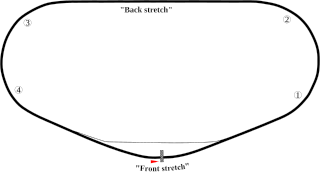
Daytona International Speedway is a race track in Daytona Beach, Florida, United States. Since opening in 1959, it has been the home of the Daytona 500, the most prestigious race in NASCAR as well as its season opening event. In addition to NASCAR, the track also hosts races of ARCA, AMA Superbike, IMSA, SCCA, and Motocross. The track features multiple layouts including the primary 2.500 mi (4.023 km) high-speed tri-oval, a 3.560 mi (5.729 km) sports car course, a 2.950 mi (4.748 km) motorcycle course, and a 1,320 ft (402.3 m) karting and motorcycle flat-track. The track's 180-acre (72.8 ha) infield includes the 29-acre (11.7 ha) Lake Lloyd, which has hosted powerboat racing. The speedway is operated by NASCAR pursuant to a lease with the City of Daytona Beach on the property that runs until 2054.

A restrictor plate or air restrictor is a device installed at the intake of an engine to limit its power. This kind of system is occasionally used in road vehicles for insurance purposes, but mainly in automobile racing, to limit top speed to provide equal level of competition, and to lower costs; insurance purposes have also factored in for motorsports.
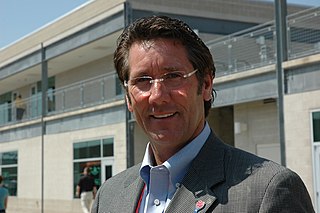
Anton Hulman "Tony" George is the former Chairman, President, and CEO of the Indianapolis Motor Speedway and Hulman & Company, serving from 1989 to 2009. He was also formerly on the Board of Directors of both entities. He founded the Indy Racing League and co-owned Vision Racing.

Oval track racing is a form of closed-circuit motorsport that is contested on an oval-shaped race track. An oval track differs from a road course in that the layout resembles an oval with turns in only one direction, and the direction of traffic is almost universally counter-clockwise. Oval tracks are dedicated motorsport circuits, used predominantly in the United States. They often have banked turns and some, despite the name, are not precisely oval, and the shape of the track can vary.
Dirt track racing is a form of motorsport held on clay or dirt surfaced oval race tracks often used for thoroughbred horse racing. Dirt track racing started in the United States before World War I and became widespread during the 1920s and 1930s using both automobiles and motorcycles. Two different types of race cars dominate — open wheel racers in the Northeast and West and stock cars in the Midwest and South. While open wheel race cars are purpose-built racing vehicles, stock cars can be either purpose-built race cars or street vehicles that have been modified to varying degrees.. There are hundreds of local and regional racetracks throughout the nation. The sport is also popular in Australia, New Zealand, Canada, South Africa and the United Kingdom.

A road course ringer, also known as road course specialist, road course expert, or a road runner, is a non-NASCAR driver who is hired by a NASCAR Cup Series or NASCAR Xfinity Series team to race, specifically on road courses.

The ARCA Menards Series is an American stock car series, the premier division of the Automobile Racing Club of America (ARCA). It is considered a minor, semi-professional league of stock car racing, used as a feeder series into the three national touring series of NASCAR, and hosts events at a variety of track types including superspeedways, road courses, and dirt tracks. The series has had a longstanding relationship with NASCAR, including using former NASCAR Cup Series cars, hosting events in the same race weekend such as Daytona Speedweeks, and naming an award after NASCAR founder Bill France, Sr. However, the series was not officially affiliated with NASCAR until its buyout on April 27, 2018.

The NASCAR Pinty's Series, commonly abbreviated as NPS, is a national NASCAR racing series in Canada, with one race in the United States, that is a continuation of the old CASCAR Super Series which was founded in 1981.
The following is a glossary of terminology used in motorsport, along with explanations of their meanings.

The NASCAR Cup Series is the top racing series of the National Association for Stock Car Auto Racing (NASCAR). The series began in 1949 as the Strictly Stock Division, and from 1950 to 1970 it was known as the Grand National Division. In 1971, when the series began leasing its naming rights to the R. J. Reynolds Tobacco Company, it was referred to as the NASCAR Winston Cup Series (1971–2003). A similar deal was made with Nextel in 2003, and it became the NASCAR Nextel Cup Series (2004–2007). Sprint acquired Nextel in 2005, and in 2008 the series was renamed the NASCAR Sprint Cup Series (2008–2016). In December 2016, it was announced that Monster Energy would become the new title sponsor, and the series was renamed the Monster Energy NASCAR Cup Series (2017–2019). In 2019, NASCAR rejected Monster's offer to extend the current naming rights deal beyond the end of the season. NASCAR subsequently announced its move to a new tiered sponsorship model beginning with the 2020 season similar to other US based professional sports leagues, where it was simply known as the NASCAR Cup Series, with the sponsors of the series being called Premier Partners. The four Premier Partners are Busch Beer, Coca-Cola, GEICO, and Xfinity.
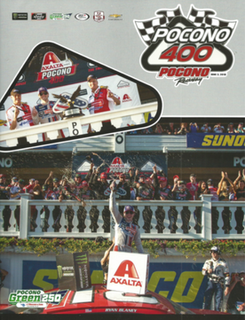
The 2018 Pocono 400 was a Monster Energy NASCAR Cup Series race held on June 3, 2018 at Pocono Raceway in Long Pond, Pennsylvania. Contested over 160 laps on the 2.5-mile (4.0 km) triangular racecourse, it was the 14th race of the 2018 Monster Energy NASCAR Cup Series season.
The 2020 General Tire #AnywhereIsPossible 200 was the fourth stock car race of the 2020 ARCA Menards Series and the 36th iteration of the event. The race was held on Friday, June 26, 2020, in Long Pond, Pennsylvania, at Pocono Raceway, a 2.5 miles triangular permanent course. The race took the scheduled 80 laps to complete. At race's end, Ty Gibbs of Joe Gibbs Racing would lead a dominant race to win his third career ARCA Menards Series win and his first of the season. To fill out the podium, Chandler Smith of Venturini Motorsports and Sam Mayer of GMS Racing would finish second and third, respectively.
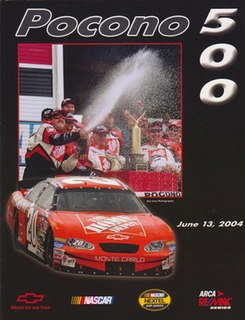
The 2004 Pocono 500 was the 14th stock car race of the 2004 NASCAR Nextel Cup Series season and the 23rd iteration of the event. The race was held on Sunday, June 13, 2004, before a crowd of 90,000 in Long Pond, Pennsylvania, at Pocono Raceway, a 2.5 miles triangular permanent course. The race took the scheduled 200 laps to complete. At race's end, Jimmie Johnson of Hendrick Motorsports would win the race under caution, after Jeff Burton blew an engine on lap 196. The win was Johnson's ninth NASCAR Nextel Cup Series career win and his third win of the season. To fill out the podium, Jeremy Mayfield of Evernham Motorsports and Bobby Labonte of Joe Gibbs Racing would finish second and third, respectively.

The 2004 Pennsylvania 500 was the 20th stock car race of the 2004 NASCAR Nextel Cup Series season and the 32nd iteration of the event. The race was held on Sunday, August 1, 2004, before a crowd of 90,000 in Long Pond, Pennsylvania, at Pocono Raceway, a 2.5 miles (4.0 km) triangular permanent course. The race took the scheduled 200 laps to complete. At race's end, Jimmie Johnson of Hendrick Motorsports would hold off the field on the final restart with five to go to win his 10th career NASCAR Nextel Cup Series win and his fourth win of the season, sweeping both Pocono races in 2004. To fill out the podium, Mark Martin of Roush Racing and Kasey Kahne of Evernham Motorsports would finish second and third, respectively.

The 2003 Pocono 500 was the 14th stock car race of the 2003 NASCAR Winston Cup Series season and the 22nd iteration of the event. The race was held on Sunday, June 8, 2003, before a crowd of 100,000 in Long Pond, Pennsylvania, at Pocono Raceway, a 2.5 miles triangular permanent course. The race took the scheduled 200 laps to complete. On the final round of pit stops on lap 190, Tony Stewart of Joe Gibbs Racing would cycle to the lead and hold off the field to win under caution when a crash occurred on lap 198 to give Stewart his 16th career NASCAR Winston Cup Series win and his first of the season. To fill out the podium, Mark Martin and Matt Kenseth of Roush Racing would finish second and third, respectively.
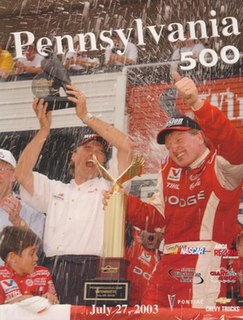
The 2003 Pennsylvania 500 was the 20th stock car race of the 2003 NASCAR Winston Cup Series season and the 31st iteration of the event. The race was held on Sunday, July 27, 2003, before a crowd of 100,000 in Long Pond, Pennsylvania, at Pocono Raceway, a 2.5 miles (4.0 km) triangular permanent course. The race took the scheduled 200 laps to complete. At race's end, Ryan Newman of Penske Racing South would manage to hold off eventual-second-place finisher Kurt Busch of Roush Racing to win his fifth career NASCAR Winston Cup Series and his fourth win of the year. To fill out the podium, Dale Earnhardt Jr. of Dale Earnhardt, Inc. would finish third.
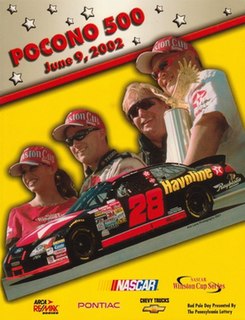
The 2002 Pocono 500 was the 14th stock car race of the 2002 NASCAR Winston Cup Series and the 21st iteration of the event. The race was held on Sunday, June 9, 2002, Long Pond, Pennsylvania, at Pocono Raceway, a 2.5 miles (4.0 km) triangular permanent course. The race took the scheduled 200 laps to complete. At race's end, Dale Jarrett, driving for Robert Yates Racing, would pass disaster-stricken teammate Ricky Rudd with six to go when Rudd blew a tire while coasting to the finish on the final lap. As a result, the race would end under caution, and Jarrett would win his 29th career NASCAR Winston Cup Series win and his first and only win of the season. To fill out the podium, Mark Martin of Roush Racing and Jimmie Johnson of Hendrick Motorsports would finish second and third, respectively.































